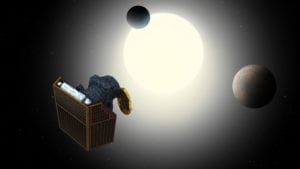
The cover on the CHEOPS space telescope was opened successfully on 29 January 2020. It is now being tested for precision and its first images are being produced. CHEOPS is a joint mission of the European Space Agency (ESA) and Switzerland, led by the University of Bern, in collaboration with the University of Geneva.
The Mission Operation Center (MOC) at the Instituto Nacional de Técnica Aeroespacial (INTA), near Madrid, Spain, gave the command to open the CHEOPS cover. “The cover was opened by sending electricity to heat an element which held the cover closed. The heat deformed this element and the cover sprung open. A retaining fixture caught the cover,” explained Willy Benz, professor of astrophysics at the University of Bern and principal investigator of the CHEOPS mission. “Thanks to the measurements of the sensors installed, we knew within minutes that everything had worked as planned.”
The successful opening of the cover marks the beginning of a series of new activities.
“In the next two months, many stars with and without planets will be targeted in order to examine the measurement accuracy of CHEOPS under different conditions,” Benz continued.
In addition, these activities allow training in all aspects of the ground segment, as the Science Operations Center at the observatory of the University of Geneva anticipates the beginning of the regular science operation phase. “The raw data of CHEOPS are being processed in the so-called data reduction pipeline,” said David Ehrenreich, CHEOPS project scientist at the University of Geneva.
CHEOPS has already produced hundreds of images; although these were completely black because the cover was still closed, they have helped the team to calibrate the instrument.
“The complete assessment of the abilities of CHEOPS and the ground segment will take some time,” Ehrenreich explained. ‘However, we expect to be able to analyze and publish the first images within one or two weeks.”
CHEOPS is the first exoplanetary mission of the ESA. It is also the first satellite built by Airbus in Spain for ESA. CHEOPS will characterize exoplanets of nearby stars, observing known planets in the size range between Earth and Neptune and precisely measuring their radii to determine their density and understand what they are made of. The satellite uses proven technologies to pave the way for bigger and more ambitious missions—with the aim of verifying if any exoplanet may be capable of supporting life. The mission was successfully launched on 18 December 2019 from the European spaceport in Kourou, French Guiana, aboard an Arianespace Soyuz launch vehicle.





